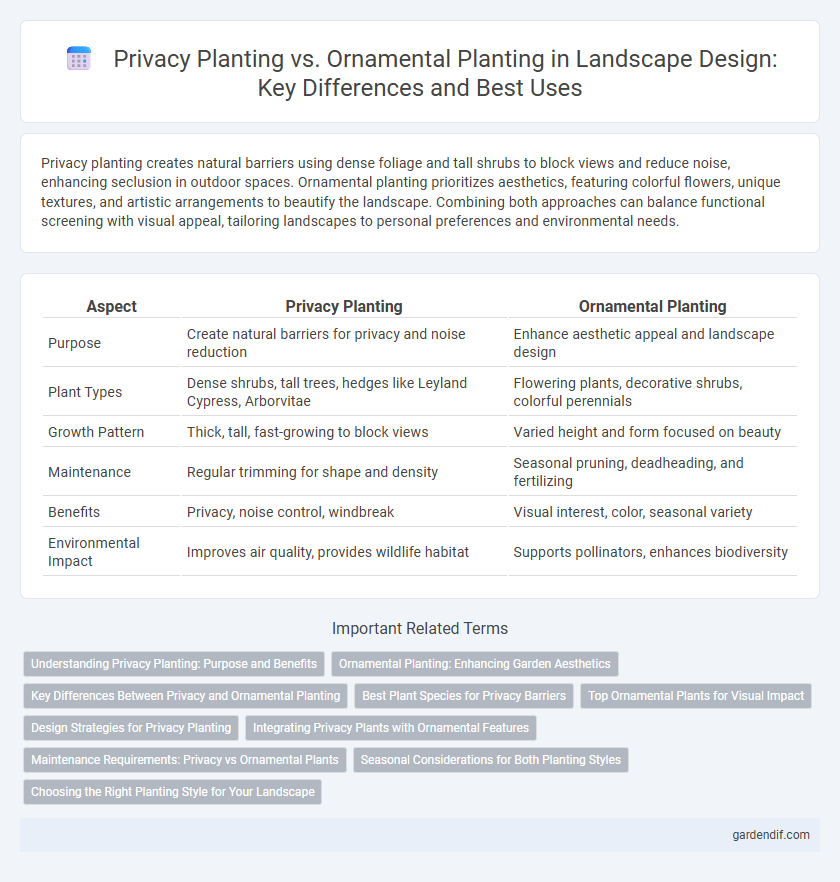
Privacy Planting vs Ornamental Planting Illustration
Privacy planting creates natural barriers using dense foliage and tall shrubs to block views and reduce noise, enhancing seclusion in outdoor spaces. Ornamental planting prioritizes aesthetics, featuring colorful flowers, unique textures, and artistic arrangements to beautify the landscape. Combining both approaches can balance functional screening with visual appeal, tailoring landscapes to personal preferences and environmental needs.
Table of Comparison
| Aspect | Privacy Planting | Ornamental Planting |
|---|---|---|
| Purpose | Create natural barriers for privacy and noise reduction | Enhance aesthetic appeal and landscape design |
| Plant Types | Dense shrubs, tall trees, hedges like Leyland Cypress, Arborvitae | Flowering plants, decorative shrubs, colorful perennials |
| Growth Pattern | Thick, tall, fast-growing to block views | Varied height and form focused on beauty |
| Maintenance | Regular trimming for shape and density | Seasonal pruning, deadheading, and fertilizing |
| Benefits | Privacy, noise control, windbreak | Visual interest, color, seasonal variety |
| Environmental Impact | Improves air quality, provides wildlife habitat | Supports pollinators, enhances biodiversity |
Understanding Privacy Planting: Purpose and Benefits
Privacy planting involves strategically placing dense, tall, and often evergreen plants to create natural barriers that block views and reduce noise, enhancing outdoor seclusion. Common species used include arborvitae, cypress, and bamboo, which provide year-round coverage and contribute to environmental benefits like air purification. This approach not only increases property value by defining boundaries but also supports mental well-being through increased security and a sense of personal space.
Ornamental Planting: Enhancing Garden Aesthetics
Ornamental planting focuses on enhancing garden aesthetics through the strategic selection of colorful flowers, textured foliage, and visually striking plants that create vibrant, dynamic landscapes. By incorporating species such as roses, hydrangeas, and Japanese maples, gardeners can achieve layered compositions that provide seasonal interest and artistic appeal. These plants not only elevate the garden's visual impact but also attract pollinators, contributing to a balanced ecosystem.
Key Differences Between Privacy and Ornamental Planting
Privacy planting primarily focuses on creating dense, tall barriers using fast-growing evergreens or shrubs like arborvitae and bamboo to block views and reduce noise. Ornamental planting emphasizes aesthetic appeal with diverse colors, textures, and seasonal blooms using flowering plants, perennials, and decorative grasses. Key differences include the purpose--privacy and screening versus visual enhancement--and plant selection based on growth habits and maintenance requirements.
Best Plant Species for Privacy Barriers
Evergreen shrubs like Thuja Green Giant and Leyland Cypress offer dense year-round coverage, making them ideal for privacy planting. For ornamental planting that also provides some privacy, consider flowering plants such as Viburnum or Camellia, which enhance aesthetics while offering moderate screening. Bamboo varieties like Fargesia can create fast-growing, tall privacy barriers with a striking visual appeal.
Top Ornamental Plants for Visual Impact
Top ornamental plants for visual impact in landscape design include hydrangeas, boxwoods, and Japanese maples, known for their vibrant colors and structured forms. Privacy planting focuses on dense, fast-growing species like arborvitae, bamboo, and holly to create effective natural screens. Selecting plants that combine aesthetic appeal with growth habits tailored to privacy needs enhances both beauty and function in outdoor spaces.
Design Strategies for Privacy Planting
Effective privacy planting design strategies include using dense, tall evergreens such as arborvitae or cypress to create year-round screening, complemented by layered shrubbery like holly or boxwood to add depth and block sightlines. Strategic placement of plants at varying heights and spacing enhances natural barriers while allowing airflow and light penetration, promoting healthy growth and sustained privacy. Incorporating native, drought-tolerant species reduces maintenance and ensures adaptability to local climate conditions, optimizing long-term landscape privacy solutions.
Integrating Privacy Plants with Ornamental Features
Integrating privacy plants with ornamental features enhances landscape design by combining functionality and aesthetic appeal, using dense evergreens like arborvitae or bamboo alongside flowering shrubs such as hydrangeas or azaleas. Layering different plant heights and textures not only creates effective privacy screens but also introduces seasonal colors and focal points that enrich garden ambiance. Strategic placement of privacy plants near patios or outdoor lounges maximizes seclusion while complementing ornamental beds for a balanced, visually engaging environment.
Maintenance Requirements: Privacy vs Ornamental Plants
Privacy planting typically involves dense, fast-growing species like arborvitae or bamboo, which require regular trimming and pruning to maintain height and thickness for effective screening. Ornamental planting emphasizes aesthetic appeal with varied species such as flowering shrubs and perennials, often needing seasonal care like deadheading, fertilizing, and pest management. Maintenance of privacy plants centers on structural upkeep and growth control, while ornamental plants demand more detailed attention to blooming cycles and visual health.
Seasonal Considerations for Both Planting Styles
Privacy planting requires selecting fast-growing, dense evergreens or deciduous species that maintain coverage year-round, such as arborvitae or holly, to ensure continuous screening throughout all seasons. Ornamental planting emphasizes seasonal interest, incorporating a mix of flowering perennials, shrubs, and bulbs like tulips, hydrangeas, and ornamental grasses that provide varying textures and colors from spring through fall. Proper timing for planting and maintenance, aligned with regional climate patterns, supports optimal growth and aesthetic appeal in both privacy and ornamental garden designs.
Choosing the Right Planting Style for Your Landscape
Privacy planting involves selecting dense, fast-growing shrubs or trees such as arborvitae, leyland cypress, or bamboo to create natural barriers that block views and reduce noise. Ornamental planting focuses on aesthetically pleasing species like hydrangeas, roses, or Japanese maple, enhancing visual appeal and seasonal interest without necessarily providing seclusion. Choosing the right planting style depends on your landscape goals, site conditions, and maintenance capabilities, balancing privacy needs with decorative preferences.
Privacy Planting vs Ornamental Planting Infographic

 gardendif.com
gardendif.com